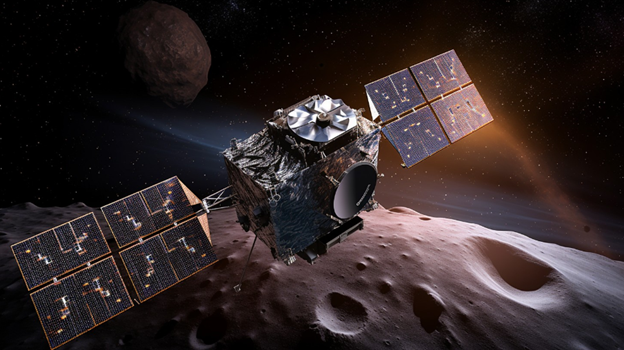The spacecraft is on its way to a unique metal-rich asteroid, orbiting the Sun between Mars and Jupiter. Scientists believe this asteroid is the nickel-iron core of an early planet, studying which could provide unique insights into the impenetrable iron core of our own planet.
Simultaneously, it will also carry out another mission that might hold the key to future space exploration.
Psyche spacecraft
● The Psyche spacecraft is the first to carry a Deep Space Optical Communications (DSOC) transceiver, and will be testing high-bandwidth optical communications to Earth during the first two years of the spacecraft’s journey to the main asteroid belt.
● DSOC, however, is taking optical communications into deep space, paving the way for high-bandwidth communications far beyond the Moon and over a 1,000times farther than any optical communications test to date.
● With humanity’s ambitions to travel in space, far beyond the Moon, improving communications technology is crucial.
● Achieving first light is one of many critical DSOC milestones in the coming months, paving the way toward higher-data-rate communications capable of sending scientific information, high-definition imagery, and streaming video in support of humanity’s next giant leap: sending humans to Mars.
Significance of Deep Space Optical Communications (DSOC)
This is where NASA’s Deep Space Optical Communications (DSOC) experiment comes in — pioneering the use of near-infrared laser signals for communication with spacecraft. Much like fibre optics replacing old telephone lines on Earth, NASA says that DSOC will allow data rates at least 10 times higher than state-of-the-art radio telecommunications systems of comparable size and power, enabling higher
resolution images, larger volumes of science data, and even streaming video.
Mars to Earth: Image
● “The images are stored digitally on Curiosity’s computer, [and then sent to] one of two Mars orbiters – Mars Odyssey and Mars Reconnaissance Orbiter (MRO) – that fly overhead in the mid- to late afternoon on Mars,”
● Once an orbiter receives the data, it beams it to large dish-shaped antennas of the Deep Space Network (DSN). There are three DSN stations around Earth – in Spain, Australia and California – and the data gets picked up by the antenna that is more “in line” with the orbiter sending it.
● Odyssey sends the information at 256Kbps (kilobits per second) – much slower than MRO’s rate of 2Mbps (megabits per second) at closest range which is comparable to the average broadband speed on Earth.
● The fastest time it takes for a high-resolution, colour image to arrive at Nasa from the moment it is snapped by the rover is about 30 minutes – but it may take up to several hours


I needed to thank you for this excellent read!!
I absolutely loved every bit of it. I’ve got you book-marked to check out new stuff
you post…